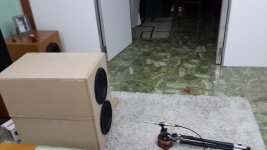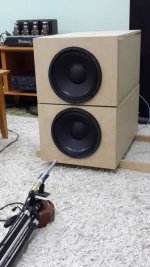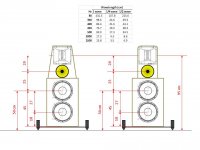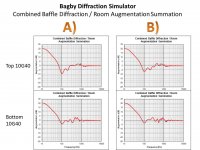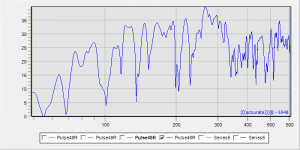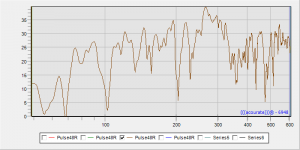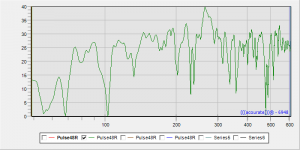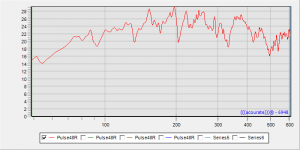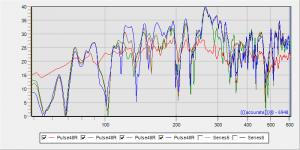So I finallly got to testing something. Fun! I would very much welcome input from experienced folks.
Context: I'm designing a 4-way active system using digital crossovers, linear phase, time-aligned. The bottom end will be handled by two Rythmik 12" in DIY sealed enclosures. The midbass will be handled by two 10G40 per side in their own sealed boxes, playing from 60-80Hz to somwehere in the 350-500Hz range. On paper two 10G40 per side seem best, but I might end up with one per side.
Midrange will be taken care of by a 6.5" or 8", and the top end will be handled by a Beyma TPL-150H.
The baffle is 40cm wide, so baffle step F3 comes in at 290Hz. Using Bagby's Diffraction Simulator I concluded using two drivers would better allow for mitigating baffle step.
I built super simple boxes in 15mm MDF, sealed, and with no filling, to try out how the drivers perform with different volumes. The back plate is built in such a way that it allows for easily changing box volume. Each box has a front baffle of 40cm wide x 30cm high. One box is 40 liters (net of the driver volume) and that represents a Qtc of 0.41. The other box is 56 liters and has Qtc of 0.38.
Below you can see a couple of pictures of the measurement setup and the frequency response. The boxes are placed in the middle of the room 1.7m from the front wall, 3m from the back wall, and 4m from the side walls. I had both boxes one in top of the other to have the baffle effect in there, but only the bottom driver was playing and the mic was 30cm away from the dustcap and on axis with the bottom driver.
The frequency response shows unsmoothed measurements, red is in a 40 liter box and green is in 56 liter box. What should I conclude?
I'm thinking xo at 60Hz won't work, while 70Hz might be a good idea. I use Acourate software for DSP and it only trims response (no boosting). Looking at 70 to 500Hz I see the red line plays louder until 350Hz, but it displays the trough in 400-450Hz.
I'm thinking:
I believe the next steps are:
Context: I'm designing a 4-way active system using digital crossovers, linear phase, time-aligned. The bottom end will be handled by two Rythmik 12" in DIY sealed enclosures. The midbass will be handled by two 10G40 per side in their own sealed boxes, playing from 60-80Hz to somwehere in the 350-500Hz range. On paper two 10G40 per side seem best, but I might end up with one per side.
Midrange will be taken care of by a 6.5" or 8", and the top end will be handled by a Beyma TPL-150H.
The baffle is 40cm wide, so baffle step F3 comes in at 290Hz. Using Bagby's Diffraction Simulator I concluded using two drivers would better allow for mitigating baffle step.
I built super simple boxes in 15mm MDF, sealed, and with no filling, to try out how the drivers perform with different volumes. The back plate is built in such a way that it allows for easily changing box volume. Each box has a front baffle of 40cm wide x 30cm high. One box is 40 liters (net of the driver volume) and that represents a Qtc of 0.41. The other box is 56 liters and has Qtc of 0.38.
Below you can see a couple of pictures of the measurement setup and the frequency response. The boxes are placed in the middle of the room 1.7m from the front wall, 3m from the back wall, and 4m from the side walls. I had both boxes one in top of the other to have the baffle effect in there, but only the bottom driver was playing and the mic was 30cm away from the dustcap and on axis with the bottom driver.
The frequency response shows unsmoothed measurements, red is in a 40 liter box and green is in 56 liter box. What should I conclude?
I'm thinking xo at 60Hz won't work, while 70Hz might be a good idea. I use Acourate software for DSP and it only trims response (no boosting). Looking at 70 to 500Hz I see the red line plays louder until 350Hz, but it displays the trough in 400-450Hz.
I'm thinking:
- If using 70 thru 500Hz I would be better off using the green line, 56 liter enclosure, because I would need to trim less (at about 18 it would do).
- But if playing 70 through 400Hz then the red line might be a better idea.
I believe the next steps are:
- Choosing either 40 or 56 liter, and run both drivers with the same volume.
- If going smaller, try 40 and maybe 30 liter (Qtc = 0.44), in both top and bottom in parallel.
- Try adding stuffing in there to understand the impact.
Attachments
A 9l -10l sealed box volume should deliver Qtc~0.7 which is the more common Butterworth alignment. You would probably find it useful to try a 9.5l sealed box volume to educate your hearing to this transisent response.
Do these cabinets have basic cross-bracing? A 90db/watt midbass can rattle a side panel with 1-watt. Perhaps the 200Hz/400/800Hz dips are box resonances.
Have you listened/measured the 10G40 ~1600Hz for Xover experiments to the TPL150H?
Nice to have early Christmas presents.
Do these cabinets have basic cross-bracing? A 90db/watt midbass can rattle a side panel with 1-watt. Perhaps the 200Hz/400/800Hz dips are box resonances.
Have you listened/measured the 10G40 ~1600Hz for Xover experiments to the TPL150H?
Nice to have early Christmas presents.
The dip you see might be because you are measuring so close.. From far enough back, the diffraction energy would be half the baffle delayed, but up close it travels back to the middle. Try something a little closer to the listening distance.
I can certainly do that. Should I also place the boxes where the speakers would sit?
A 9l -10l sealed box volume should deliver Qtc~0.7 which is the more common Butterworth alignment. You would probably find it useful to try a 9.5l sealed box volume to educate your hearing to this transisent response.
Do these cabinets have basic cross-bracing? A 90db/watt midbass can rattle a side panel with 1-watt. Perhaps the 200Hz/400/800Hz dips are box resonances.
Have you listened/measured the 10G40 ~1600Hz for Xover experiments to the TPL150H?
Nice to have early Christmas presents.
Sure. I was thinking of trying 10 liter and 20 liter. But not sure I have a critería for choosing between 40 and 56 liter...so what's the use of having more data points? That was my reasoning.
Boxes have no bracing at all - for now!
The reason I mesured the 10G40 up to 2kHz is because I plan to try them crossed to the TPL. But that is a temporary setup as I did not choose the 10G40 for its midrange ability.
Unless you want to include the room I wouldn't.I can certainly do that. Should I also place the boxes where the speakers would sit?
It's also debateable whether to keep them on the floor. You'll get a longer reflection free time with the speaker and mic at half room height, but you could push this further if you put the speaker and mic down on the floor.
observations and comments
Greetings !
Your enclosures are of too much volume. Place a partition to yield about 1/2
a cubic foot.
Stuff, but not pack too tight, the enclosures with non faced pink panther.
Take them outside and measure again. Save the measurements and compare them to the ones done inside.
Greetings !
Your enclosures are of too much volume. Place a partition to yield about 1/2
a cubic foot.
Stuff, but not pack too tight, the enclosures with non faced pink panther.
Take them outside and measure again. Save the measurements and compare them to the ones done inside.
It's also debateable whether to keep them on the floor. You'll get a longer reflection free time with the speaker and mic at half room height, but you could push this further if you put the speaker and mic down on the floor.
I know you are right in terms of the reflection-free time. As you say, I debate with myself as to wether this is better or not for the case at hand. At the end of the day what I'm concerned with is the performance of these drivers used at about these heights in this specific room, rather than evaluating the performance of the driver alone.
Greetings !
Your enclosures are of too much volume. Place a partition to yield about 1/2
a cubic foot.
Stuff, but not pack too tight, the enclosures with non faced pink panther.
Take them outside and measure again. Save the measurements and compare them to the ones done inside.
Hey Scott!
Stuffing is definitely in the to-do list. I'll probably use first something like a pillow before manipulating glass fiber from box to box in the living room
Measuring outside is also in the to-do list, but as a step towards linearizing the drivers. My thinking is this is cumbersome enough for me (I live in an apartment building) to want to experiment with box sizes indoors and once settled for a given size, go measure outside too. What would I miss by doing it this way?
Nice project. What made you choose that Beyma tweeter? Don't read my comment as good or bad. I have no experience with the Kapton drivers.
Thank you!
Why the TPL? I saw a relative uniform opinion air motion tweeters are extremely good, and the Raal and Beyma were generally the standouts. I like the higher efficiency of the Beyma and the mentioned higher dynamics. I would love to drive tweeters and midranges with SET 45 or 2A3, so eficiency is important.
The TPL-150H was chosen because a) it offered a better directivity match with a 6.5" or 8" midrange driver, and b) it further improved sensitivity to 102 dB/2.83V.
Very rarely have I seen in audio such a strong "agreement" of anything being so good. Obviously not everyone agrees, but very manyconsidering this is audio. And some like other units better, but I can't recall people saying this driver is not good. Very unusual, I think.
It shouldn't be too hard to measure down to to 200Hz in a typical room. Below this, the speaker response is eaiser to predict and can even be interpolated from nearfield measurements, and doesn't even matter that much due to the rooms influence. If you are trying to measure the baffle influence you probably only want to know where the slope is and what it looks like above this.
If your room height is the smaller dimension you'll get the first cancellation near 70Hz. Putting space between the speaker and mic will raise this frequency, ground planing will reduce it. I'd prefer not to ground plane for higher frequencies.
I'd try to find the greatest attainable gating distance in your room and measure down to that frequency, then find an alternative for measuring below that.
If your room height is the smaller dimension you'll get the first cancellation near 70Hz. Putting space between the speaker and mic will raise this frequency, ground planing will reduce it. I'd prefer not to ground plane for higher frequencies.
I'd try to find the greatest attainable gating distance in your room and measure down to that frequency, then find an alternative for measuring below that.
You may want to look at Charlie Laub and Jeff Bagby's FRD Blender. They provide a way to splice near and far field measurements to derive a valid frequency response indoors.
FRD Blender and Minimum Phase Extractor
Bill
FRD Blender and Minimum Phase Extractor
Bill
I think that using two 10 inch drivers is a mistake. You will find that unless you are running a nightclub, that it will make no real difference to the SPL you can produce - but you will get all manner of ripple in your frequency response as a result of there being two drivers a side.
If you have put two drivers there for SPL, just hook up a big amplifier, they will take it and deliver very high SPL. Especially if they are not trying to deliver bass at the same time!
Your near field measurement show this very well.
I have found the Beyma published data to be reliable for all the drivers I have used. I have not tested the 10g40, but I do use the TPL150h matched to a 10 inch driver with great success.
If you have DSP crossover available I would try running one 10g40 per side crossing to the TPL 150 at somewhere between 1500 and 2000Hz.
If you have bass drivers on both left and right channels (I.e. Not s seperate sub) then I would strongly consider running the subs up to a higher frequency than you suggested. This would result in the bulk of large come excursions being handled by the sub. As a result your mid will be cleaner as the driver will not be trying to generate midrange on a cone moving back and forth.
If you have put two drivers there for SPL, just hook up a big amplifier, they will take it and deliver very high SPL. Especially if they are not trying to deliver bass at the same time!
Your near field measurement show this very well.
I have found the Beyma published data to be reliable for all the drivers I have used. I have not tested the 10g40, but I do use the TPL150h matched to a 10 inch driver with great success.
If you have DSP crossover available I would try running one 10g40 per side crossing to the TPL 150 at somewhere between 1500 and 2000Hz.
If you have bass drivers on both left and right channels (I.e. Not s seperate sub) then I would strongly consider running the subs up to a higher frequency than you suggested. This would result in the bulk of large come excursions being handled by the sub. As a result your mid will be cleaner as the driver will not be trying to generate midrange on a cone moving back and forth.
It seems few people perform micro-equalisation correctly, or even consider it. I think this has to account for some of the hype where they choose drivers that have a naturally clean response. Sometimes a naturally clean response is a sign of a good driver but not always.but I can't recall people saying this driver is not good. Very unusual, I think.
For example when a driver is on a horn, the horn is more responsible for the result. EQ is typically required and would of course balance the driver as well in the process.
One thing people who like ribbons have said they like is the directivity of the line.
you don't need to limit yourself to thinking you can only cut as you can apply boost with acourateI use Acourate software for DSP and it only trims response (no boosting).
I think that using two 10 inch drivers is a mistake. You will find that unless you are running a nightclub, that it will make no real difference to the SPL you can produce - but you will get all manner of ripple in your frequency response as a result of there being two drivers a side.
If you have put two drivers there for SPL, just hook up a big amplifier, they will take it and deliver very high SPL. Especially if they are not trying to deliver bass at the same time!
Your near field measurement show this very well.
I have found the Beyma published data to be reliable for all the drivers I have used. I have not tested the 10g40, but I do use the TPL150h matched to a 10 inch driver with great success.
If you have DSP crossover available I would try running one 10g40 per side crossing to the TPL 150 at somewhere between 1500 and 2000Hz.
If you have bass drivers on both left and right channels (I.e. Not s seperate sub) then I would strongly consider running the subs up to a higher frequency than you suggested. This would result in the bulk of large come excursions being handled by the sub. As a result your mid will be cleaner as the driver will not be trying to generate midrange on a cone moving back and forth.
I'm not sure you are right. Twin 10G40 per side are not for SPL. One would reach max SPL needed, as you say. The reasons for twin drivers:
- keep maximum displacement at 20% of Xmax vs 50% with one driver, thus reducing distortion.
- Achieve almost the same volume displaced at 80Hz and 105dB than a 12", while keeping displacement very low, using drivers with very low F3 at Qtc=0.707.
- Get 86% of SD of a 15", but with all of the above.
- Two drivers allow for better mitigating baffle step. See the simulations using Bagby's software below.
- The 10G40 were not chosen for their midrange ability. Hence I don't think it's a good idea to think about them as midranges, despite me likely crossing them to the TPL temporarily as the project evolves.
Attachments
I finally had time today to measure again:
What do you guys see?
- Red: lower driver only in 56 liter box, measured at 30cm and 10cm high (same as before, for reference). Qtc=0.41
- Green: again lower driver in 56 liter box, measured on axis at 185cm away and 95cm high (ear level)
- Brown: 20 liter box, measured on axis at 185cm away and 95cm high
- Red: 10 liter box, measured on axis at 185cm away and 95cm high
- All of them together. Busy chart.
What do you guys see?
Attachments
- Status
- This old topic is closed. If you want to reopen this topic, contact a moderator using the "Report Post" button.
- Home
- Loudspeakers
- Multi-Way
- Midbass section design with Beyma 10G40
